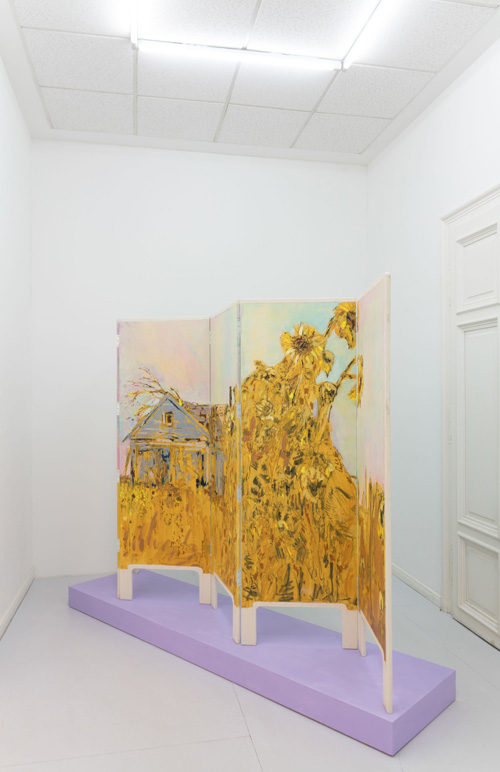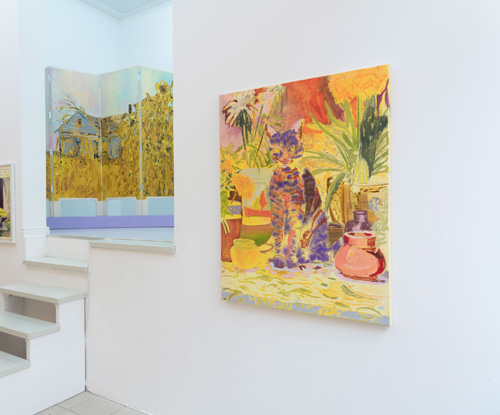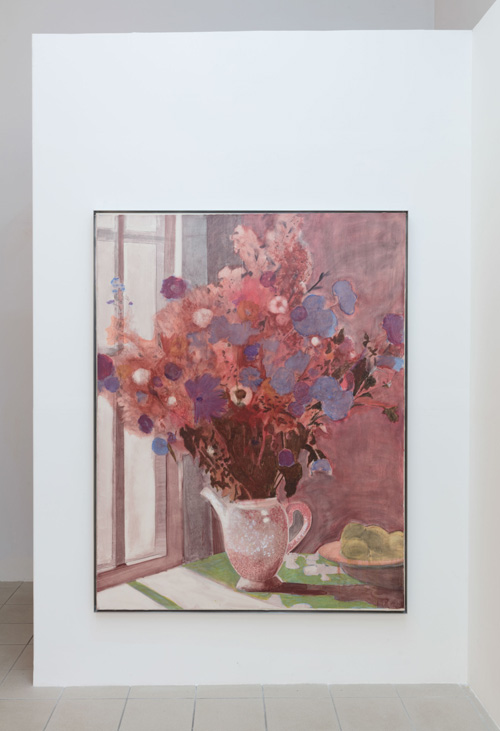ALTE NEUE SONNE
Location:
Galerie Nina Mielcarczyk
Käthe–Kollwitz–Straße 13, Leipzig
Date:
13. Januar. 2024 18:00
-
01. März. 2024
Participating artists:
Laurentius Sauer, Timur Lukas
Curator:
Nina Mielcarczyk
Type of exhibition:
Solo-Show
See also:



Photo Credits: Marco Dirr
Galerie Nina Mielcarczyk presents the works of artists Laurentius Sauer and Timur Lukas, who not only share a close friendship and
a studio space, but also leave a common trace of romanticism in their work. This romantic influence extends from the subjects of the paintings (it’s the vases, floral bouquets and dreamy vistas) to their stylistic influences and the oil pastels they produce together—it’s quite adorable. But something is wrong. Beneath the aesthetic tranquillity and calm, something is moving.
“Can you paint a subject to death?” — Timur Lukas
It starts with the folding screen that shapes the space of the exhibition as its central component. In this way, their partly
graphic approaches (especially Sauer’s) gain an additional sculptural level, as an image in space. The resulting “false” perspective invites us to take a closer look at the two sides and get to the heart of the matter: The once magnificently depicted fields of sunflowers are barren and dried up, the hut, which at first seems homely, turns out to be in decay at second glance.
Decay, as the condition of growth, permeates both Sauer and Lukas’ work and thus creates the underlying disruption of the prevailing virtuosity. The lost, the left-over, the not-yet-ruined feeds the motifs of their works and also explains their shared focus on architecture. They see remnants of an apparatus that has already died, such as the villa in Lukas’ aptly titled work “classic view”, which is inspired by Harald Juhnke’s recently demolished villa. Lukas comments on this briefly in the preliminary talk:
“Little remains, soon everything will be gone.”
This approach is reflected in his research method, for which
he buys up masses of other people’s family archives and searches for motifs. He is interested in the precise composition of old photographs, how they repeat themselves and how intimate connec- tions can be established with these strangers as he flicks through their lives.
Historical influences can also be found in Sauer’s work, although he views them more critically. Abandoned barns, horses (the cowboys can’t be far), roosters, sheathed machines—all old symbols of male sovereignty. These are supplemented by short fragments of text which, in their combination, ask: How current are these symbols still and, more importantly, what has replaced them?
It can be observed that Sauer examines the symbols of our communal life, while Luke is concerned with their representation— the way in which they were/are depicted. Why is it always the
vase of flowers by the window? What is the intrinsic attraction in the old representations of male hegemony? Why do some subjects
never die out? In Old New Sun, Lukas and Sauer point out that the
answer is much darker than we may think.
[Text: Fredi Thiele]
Galerie Nina Mielcarczyk presents the works of artists Laurentius Sauer and Timur Lukas, who not only share a close friendship and
a studio space, but also leave a common trace of romanticism in their work. This romantic influence extends from the subjects of the paintings (it’s the vases, floral bouquets and dreamy vistas) to their stylistic influences and the oil pastels they produce together—it’s quite adorable. But something is wrong. Beneath the aesthetic tranquillity and calm, something is moving.
“Can you paint a subject to death?” — Timur Lukas
It starts with the folding screen that shapes the space of the exhibition as its central component. In this way, their partly
graphic approaches (especially Sauer’s) gain an additional sculptural level, as an image in space. The resulting “false” perspective invites us to take a closer look at the two sides and get to the heart of the matter: The once magnificently depicted fields of sunflowers are barren and dried up, the hut, which at first seems homely, turns out to be in decay at second glance.
Decay, as the condition of growth, permeates both Sauer and Lukas’ work and thus creates the underlying disruption of the prevailing virtuosity. The lost, the left-over, the not-yet-ruined feeds the motifs of their works and also explains their shared focus on architecture. They see remnants of an apparatus that has already died, such as the villa in Lukas’ aptly titled work “classic view”, which is inspired by Harald Juhnke’s recently demolished villa. Lukas comments on this briefly in the preliminary talk:
“Little remains, soon everything will be gone.”
This approach is reflected in his research method, for which
he buys up masses of other people’s family archives and searches for motifs. He is interested in the precise composition of old photographs, how they repeat themselves and how intimate connec- tions can be established with these strangers as he flicks through their lives.
Historical influences can also be found in Sauer’s work, although he views them more critically. Abandoned barns, horses (the cowboys can’t be far), roosters, sheathed machines—all old symbols of male sovereignty. These are supplemented by short fragments of text which, in their combination, ask: How current are these symbols still and, more importantly, what has replaced them?
It can be observed that Sauer examines the symbols of our communal life, while Luke is concerned with their representation— the way in which they were/are depicted. Why is it always the
vase of flowers by the window? What is the intrinsic attraction in the old representations of male hegemony? Why do some subjects
never die out? In Old New Sun, Lukas and Sauer point out that the
answer is much darker than we may think.
[Text: Fredi Thiele]